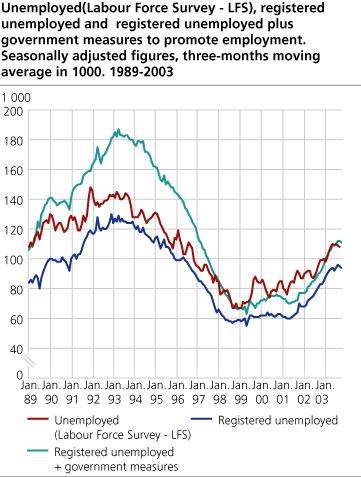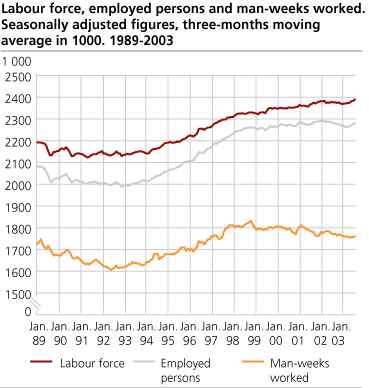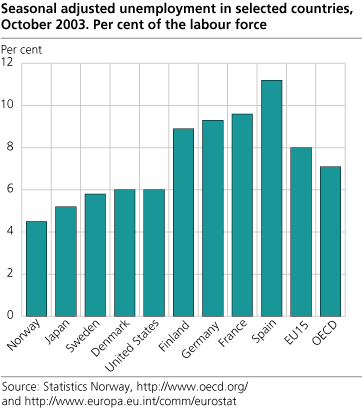Content
Published:
This is an archived release.
Employment on the rise
Unemployment remained unchanged in the last three-month period. At the same time, employment has increased from May 2003.
Norwegian unemployment has gradually increased since the autumn 1999, according to seasonally adjusted figures from the Labour Force Survey (LFS). From the three-month period June-August to September-November 2003, total unemployment decreased by 1 000 people, which is inside the error margins. In per cent of the labour force the unemployment went down by 0.1 percentage points. Seasonally adjusted figures of registered unemployed people at the Employment Offices showed a slight increase over the same period.
After a period of strong growth, employment has just shown a slight increase from 1999, and in 2002 the number of employed people started to fall. In every three-month period from April-June to September-November 2003, employment has increased. This gives a total of 19 000 people, which is outside the error margin.
Higher unemployment in Sweden and Denmark
The seasonally adjusted unemployment rate in Norway decreased from 4.6 per cent in July to 4.5 per cent in October 2003. In the same period the unemployment stayed unchanged at 8.0 per cent as an average in the EU member countries. The unemployment rate in the OECD-countries as a whole went down from 7.2 to 7.1 per cent. In the USA, the unemployment rate amounted to 6.0 per cent in October, a decrease of 0.2 percentage point from July. The unemployment rate in Sweden increased from 5.5 per cent in July to 5.8 per cent in October, from 5.7 to 6.0 per cent in Denmark, while it went down from 9.1 to 8.9 per cent in Finland. In the same period, unemployment remained unchanged in Germany, while it went up in France by 0.2 percentage points. This is according to figures from OECD and Eurostat .
Man-weeks worked have shown a decreasing trend since the autumn 1999. The last three-month period man-weeks worked increased by 8 000, which is inside the margin of errors.
Uncertain figures
Quality tests show that the seasonally adjusted LFS unemployment figures are uncertain. The seasonal-adjustment method has problems identifying a stable seasonal pattern for this series. The random component is relatively large compared with the seasonal component. The figures should therefore be used with caution.
The purpose of adjusting for seasonal variations is to describe the development during the last year and to give figures for change between the last two 3-month periods, cleared for normal seasonal variations. In order to reduce uncertainty, the presented series are three months moving averages of the seasonally adjusted figures. For instance, the figures for October are the average of the estimates from September, October and November.
Tables:
The statistics is published with Labour force survey.
Contact
-
Arbeidsmarked og lønn
E-mail: arbeidsmarked@ssb.no
-
Erik Herstad Horgen
E-mail: erik.horgen@ssb.no
tel.: (+47) 93 08 68 62



